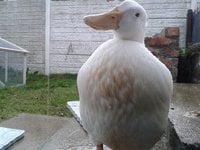General Information
Campbell is a breed of domesticated duck that originated in England and is kept for its high level of egg production. The breed was developed by Adele Campbell of England at the end of the 19th century. The "Khaki" portion of the name refers to the duck's typical color.
Adult Campbell ducks weigh approximately 4 pounds. Campbells can come in three color varieties: khaki, dark and white. The Khaki Campbell duck is mostly khaki colored with a darker head. They are a cross between Mallard, Rouen and Runner ducks.
The egg production of the Campbell breed can exceed even the most efficient of egg laying domestic chickens, with the breed laying an average of 300 eggs a year.
Campbells become mature at approximately 6 months. Campbell hens very seldom will hatch out others young. Brooding behavior has been sacrificed in exchange for prolific egg laying ability in this breed. Mechanical incubators or broody chickens are used to hatch out Campbell ducklings. It takes approximately 28 days for a Campbell duckling to hatch.
In the late 1800s Adele Campbell purchased a Fawn and White Indian Runner Duck which was an exceptional layer (195 eggs in 197 days) and crossed it with a Rouen Duck in an attempt to create a strain that would lay well and have bigger bodies. The offspring were crossed with Mallards to increase their hardiness. The resulting birds were prolific layers. The "Campbell" breed was introduced to the public in 1898.
---
Genetic profile White
Gene :Recessive white/ symbol c/ Recessive
This gene is responsible for the white in common white breeds. In the homozygous state, recessive white masks all other color genes . as in the White Campbell
Adult Campbell ducks weigh approximately 4 pounds. Campbells can come in three color varieties: khaki, dark and white. The Khaki Campbell duck is mostly khaki colored with a darker head. They are a cross between Mallard, Rouen and Runner ducks.
The egg production of the Campbell breed can exceed even the most efficient of egg laying domestic chickens, with the breed laying an average of 300 eggs a year.
Campbells become mature at approximately 6 months. Campbell hens very seldom will hatch out others young. Brooding behavior has been sacrificed in exchange for prolific egg laying ability in this breed. Mechanical incubators or broody chickens are used to hatch out Campbell ducklings. It takes approximately 28 days for a Campbell duckling to hatch.
In the late 1800s Adele Campbell purchased a Fawn and White Indian Runner Duck which was an exceptional layer (195 eggs in 197 days) and crossed it with a Rouen Duck in an attempt to create a strain that would lay well and have bigger bodies. The offspring were crossed with Mallards to increase their hardiness. The resulting birds were prolific layers. The "Campbell" breed was introduced to the public in 1898.
---
Genetic profile White
Gene :Recessive white/ symbol c/ Recessive
This gene is responsible for the white in common white breeds. In the homozygous state, recessive white masks all other color genes . as in the White Campbell


